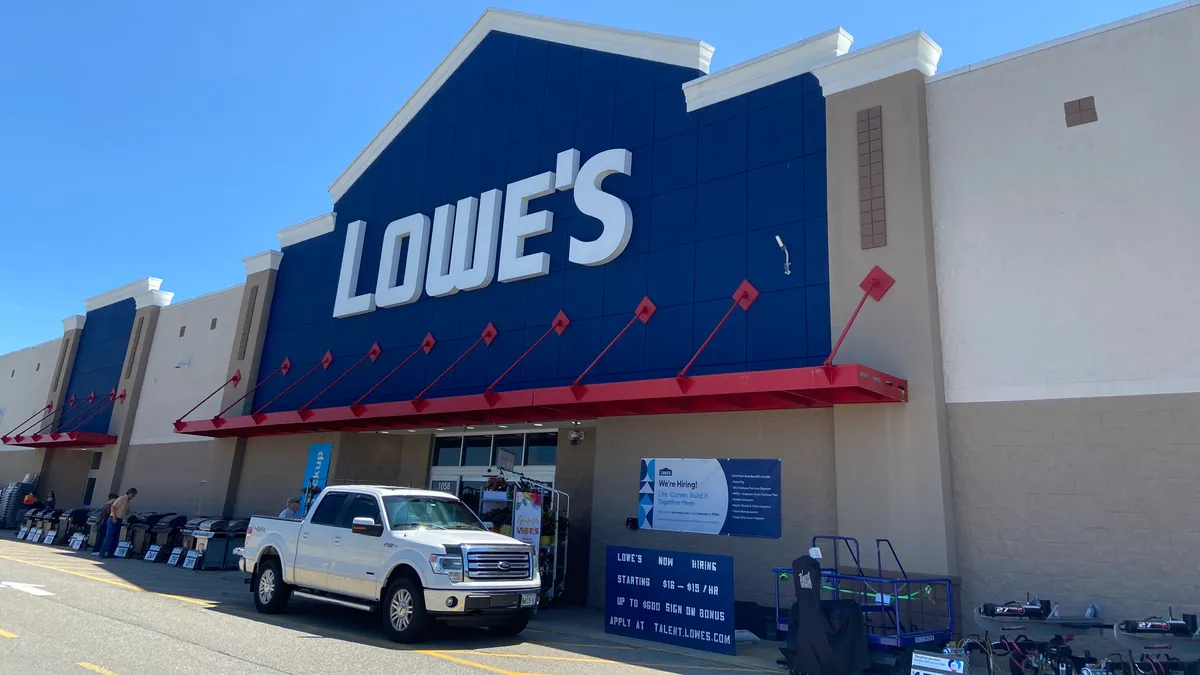Dive Brief:
- Lowe’s on Tuesday reported first-quarter net sales of $22.3 billion. Comp sales for the quarter fell 4.3% from last year due to lumber deflation, unfavorable weather and lower DIY discretionary sales.
- Operating income was $3.3 billion, almost flat from last year, while net earnings for the quarter ending May 5 fell to $2.26 billion, down from $2.33 billion last year.
- Although the company’s performance exceeded analyst expectations, Lowe’s lowered its full-year sales forecast. The company now expects total sales of $87 billion to $89 billion, down from previous guidance of $88 billion to $90 billion, and a comp sales decline of 2% to 4%. Lowe’s had previously expected comp sales would be flat to a 2% decline.
Dive Insight:
CEO Marvin Ellison said a late start to spring chilled the company’s Q1 performance.
Ellison said the company’s do-it-yourself customers represent 75% of its business and many seasonal categories are concentrated in the DIY segment. “As weather improves, we're optimistic that customers will reengage with spring projects and we are ready to support the increased demand with our best in-stock position and staffing levels in three years,” he said.
The retailer’s comp sales decline mirrors rival Home Depot’s Q1 performance, Neil Saunders, managing director of GlobalData, said in comments emailed to Retail Dive.
“While negative numbers are never good, the fact remains that Lowe’s has benefited from the DIY surge during the pandemic and is now in a period of modest reset. This quarter, sales are up by 26% compared to the same period in pre-pandemic 2019. This is a positive step forward, although it is much less of an advance than Home Depot where sales for the same periods are up 41.2%. Lowe’s will hope that its focus on being a store for all aspects of home will prevent the numbers from tumbling further,” Saunders said.
Bill Boltz, the company’s executive vice president of merchandising, said five of the company’s 14 merchandising categories were positive in Q1 — building materials, rough plumbing, paint, hardware and appliances, which sit squarely in the non-discretionary category for most people.
“In the U.S., we estimate that roughly 100,000 appliances break every day,” Boltz said. “So our investments in fast appliance delivery and a seamless omnichannel shopping experience positions us well as the go-to destination for these urgent and often non-discretionary needs,” Boltz said.
But a near-term pullback in discretionary consumer spending is still likely, which contributed to the lowered guidance. Lowe’s can’t control commodity deflation, weather or macroeconomics but “we can control how effectively we operate our business and adapt to a changing environment,” Ellison said.
Looking ahead, Ellison said Lowe’s is focused on building its market penetration of rural stores.
“While in years past, our penetration of rural and remote stores was viewed as a competitive disadvantage, we now expect these stores will be a key component of operating profit growth over the next three to five years,” Ellison said.
Boltz offered more detail on that push, saying the company plans to expand its rural store format to up to 300 more locations by year-end. The rural format stores feature more farm and ranch-focused products like fencing, specialized hardware, trailers and Carhartt apparel. Lowe’s has over 1,700 stores.
“Despite the near-term macro pressures, we believe Lowe's remains focused on increasing its market share and improving sales productivity and operating efficiency,” Telsey Advisory Group analysts led by Joe Feldman said in a note ahead of the earnings call. Feldman said in the medium term, the company should continue to benefit from focusing on its professional customers; enhancing its digital experience; improving installation services; driving localization; and elevating its assortment.
Correction: This story has been updated to reflect an accurate description of the company's store expansion plan.















